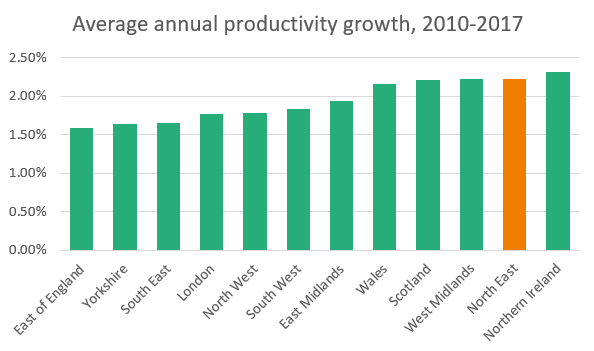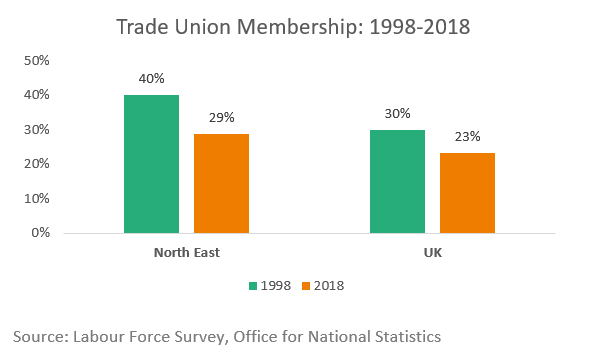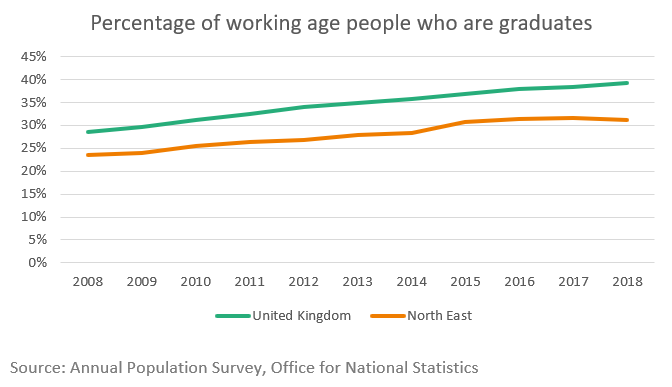REGIONAL ANALYSIS: North East
Article
This analysis was handed out at our event Economic Justice for the North East. The event was the North East instalment in a UK-wide series of public meetings held by the IPPR Centre for Economic Justice.
Productivity - In 2010,on average,workers in the North East produced goods and services worth £26 per hour. In 2017, this had risen to £30 per hour. This equates to growth of 2.2% per year, which was the second-fastest growth in the UK, joint with the West Midlands and exceeded only by Northern Ireland.1 Despite this promising growth, the average amount produced by workers in the North East remains below the UK average of £34 per hour worked.
Despite this promising growth, the average amount produced by workers in the North East remains below the UK average of £34 per hour worked.
 Despite this promising growth, the average amount produced by workers in the North East remains below the UK average of £34 per hour worked.
Despite this promising growth, the average amount produced by workers in the North East remains below the UK average of £34 per hour worked.Trade Union Membership - Trade union membership is high in the North East compared to the rest of the UK, but the North East has also seen the largest drop in trade union membership of any region or nation in the past 20 years, from four in ten workers to three in ten.2 This fall is partly explained by the loss of manufacturing jobs in the North East, where trade union membership was traditionally high. The number of workers in manufacturing in the North East has fallen from around two in ten workers in 1998 to just one in ten in 2018 – a loss of 70,000 jobs. This is a similar but slightly larger fall than across the UK as a whole. Other sectors have been growing however, with administration, education and health and social work contributing the highest numbers of new jobs since 1998.3
This fall is partly explained by the loss of manufacturing jobs in the North East, where trade union membership was traditionally high. The number of workers in manufacturing in the North East has fallen from around two in ten workers in 1998 to just one in ten in 2018 – a loss of 70,000 jobs. This is a similar but slightly larger fall than across the UK as a whole. Other sectors have been growing however, with administration, education and health and social work contributing the highest numbers of new jobs since 1998.3
 This fall is partly explained by the loss of manufacturing jobs in the North East, where trade union membership was traditionally high. The number of workers in manufacturing in the North East has fallen from around two in ten workers in 1998 to just one in ten in 2018 – a loss of 70,000 jobs. This is a similar but slightly larger fall than across the UK as a whole. Other sectors have been growing however, with administration, education and health and social work contributing the highest numbers of new jobs since 1998.3
This fall is partly explained by the loss of manufacturing jobs in the North East, where trade union membership was traditionally high. The number of workers in manufacturing in the North East has fallen from around two in ten workers in 1998 to just one in ten in 2018 – a loss of 70,000 jobs. This is a similar but slightly larger fall than across the UK as a whole. Other sectors have been growing however, with administration, education and health and social work contributing the highest numbers of new jobs since 1998.3Skills - In the North East, three in ten working-age adults have a degree or equivalent qualification. This is the lowest level in the country. Across the UK as a whole, four in ten adults have a degree. The gap between the North East and the rest of the country has been slowly widening over time.4 However, if we focus on the under-25s the gap is considerably smaller. 17% of young people in the North East have a degree, compared to 19% in the UK as a whole.5
However, if we focus on the under-25s the gap is considerably smaller. 17% of young people in the North East have a degree, compared to 19% in the UK as a whole.5
 However, if we focus on the under-25s the gap is considerably smaller. 17% of young people in the North East have a degree, compared to 19% in the UK as a whole.5
However, if we focus on the under-25s the gap is considerably smaller. 17% of young people in the North East have a degree, compared to 19% in the UK as a whole.5Housing and Wealth - In the North East, the average (median) house price is five times the average annual income. According to this measure, house prices are more affordable in the North East than anywhere else in England and Wales.6 Across England as a whole, the average house price is eight times the average income. Despite this, home ownership in the North East is the second-lowest in Great Britain, according to the latest data, with just six in ten people owning their own homes.7
Public Investment- Planned spending on transport infrastructure is £855 per person in the North East, compared to £4,155 in London – almost five times lower.8 This is the second-lowest level in England, second only to Yorkshire and the Humber.
References
- IPPR analysis using ‘Regional and sub-regional productivity in the UK 2019’, experimental statistics (ONS)
- IPPR analysis, Trade Union Statistics, sourced from the Labour Force Survey (ONS)
- IPPR analysis, workforce jobs by industry (SIC 2007) - seasonally adjusted, ONS
- IPPR analysis, Annual Population Survey (ONS)
- IPPR analysis, Annual Population Survey (ONS)
- Wealth & Assets Survey 2014-2016 (ONS)
- Wealth & Assets Survey 2014-2016 (ONS)
- IPPR North (2018), Future Transport Investment in the North
Related items

Rule of the market: How to lower UK borrowing costs
The UK is paying a premium on its borrowing costs that ‘economic fundamentals’, such as the sustainability of its public finances, cannot fully explain.
Restoring security: Understanding the effects of removing the two-child limit across the UK
The government’s decision to lift the two-child limit marks one of the most significant changes to the social security system in a decade.
Building a healthier, wealthier Britain: Launching the IPPR Centre for Health and Prosperity
Following the success of our Commission on Health and Prosperity, IPPR is excited to launch the Centre for Health and Prosperity.